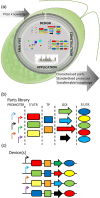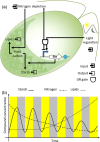Establishing Chlamydomonas reinhardtii as an industrial biotechnology host
- PMID: 25641561
- PMCID: PMC4515103
- DOI: 10.1111/tpj.12781
Establishing Chlamydomonas reinhardtii as an industrial biotechnology host
Abstract
Microalgae constitute a diverse group of eukaryotic unicellular organisms that are of interest for pure and applied research. Owing to their natural synthesis of value-added natural products microalgae are emerging as a source of sustainable chemical compounds, proteins and metabolites, including but not limited to those that could replace compounds currently made from fossil fuels. For the model microalga, Chlamydomonas reinhardtii, this has prompted a period of rapid development so that this organism is poised for exploitation as an industrial biotechnology platform. The question now is how best to achieve this? Highly advanced industrial biotechnology systems using bacteria and yeasts were established in a classical metabolic engineering manner over several decades. However, the advent of advanced molecular tools and the rise of synthetic biology provide an opportunity to expedite the development of C. reinhardtii as an industrial biotechnology platform, avoiding the process of incremental improvement. In this review we describe the current status of genetic manipulation of C. reinhardtii for metabolic engineering. We then introduce several concepts that underpin synthetic biology, and show how generic parts are identified and used in a standard manner to achieve predictable outputs. Based on this we suggest that the development of C. reinhardtii as an industrial biotechnology platform can be achieved more efficiently through adoption of a synthetic biology approach.
Keywords: Chlamydomonas reinhardtii; industrial biotechnology; metabolic engineering; rational design; synthetic biology; transgene expression.
© 2015 The Authors The Plant Journal published by Society for Experimental Biology and John Wiley & Sons Ltd.
Figures




Similar articles
-
Towards developing algal synthetic biology.Biochem Soc Trans. 2016 Jun 15;44(3):716-22. doi: 10.1042/BST20160061. Biochem Soc Trans. 2016. PMID: 27284033 Review.
-
Rational Promoter Engineering Enables Robust Terpene Production in Microalgae.ACS Synth Biol. 2021 Apr 16;10(4):847-856. doi: 10.1021/acssynbio.0c00632. Epub 2021 Mar 25. ACS Synth Biol. 2021. PMID: 33764741
-
Birth of a Photosynthetic Chassis: A MoClo Toolkit Enabling Synthetic Biology in the Microalga Chlamydomonas reinhardtii.ACS Synth Biol. 2018 Sep 21;7(9):2074-2086. doi: 10.1021/acssynbio.8b00251. Epub 2018 Sep 5. ACS Synth Biol. 2018. PMID: 30165733
-
Molecular Genetic Tools and Emerging Synthetic Biology Strategies to Increase Cellular Oil Content in Chlamydomonas reinhardtii.Plant Cell Physiol. 2019 Jun 1;60(6):1184-1196. doi: 10.1093/pcp/pcz022. Plant Cell Physiol. 2019. PMID: 30715500 Review.
-
Challenges and advances towards the rational design of microalgal synthetic promoters in Chlamydomonas reinhardtii.J Exp Bot. 2023 Jul 18;74(13):3833-3850. doi: 10.1093/jxb/erad100. J Exp Bot. 2023. PMID: 37025006
Cited by
-
Construction of Marker-Free Transgenic Strains of Chlamydomonas reinhardtii Using a Cre/loxP-Mediated Recombinase System.PLoS One. 2016 Aug 26;11(8):e0161733. doi: 10.1371/journal.pone.0161733. eCollection 2016. PLoS One. 2016. PMID: 27564988 Free PMC article.
-
Grand Challenges in Microalgae Domestication.Front Plant Sci. 2021 Sep 23;12:764573. doi: 10.3389/fpls.2021.764573. eCollection 2021. Front Plant Sci. 2021. PMID: 34630500 Free PMC article. No abstract available.
-
Dissecting the contributions of GC content and codon usage to gene expression in the model alga Chlamydomonas reinhardtii.Plant J. 2015 Nov;84(4):704-17. doi: 10.1111/tpj.13033. Epub 2015 Oct 16. Plant J. 2015. PMID: 26402748 Free PMC article.
-
In Metabolic Engineering of Eukaryotic Microalgae: Potential and Challenges Come with Great Diversity.Front Microbiol. 2015 Dec 15;6:1376. doi: 10.3389/fmicb.2015.01376. eCollection 2015. Front Microbiol. 2015. PMID: 26696985 Free PMC article. Review.
-
Identification of Chlamydomonas reinhardtii endogenous genic flanking sequences for improved transgene expression.Plant J. 2017 Dec;92(6):1232-1244. doi: 10.1111/tpj.13731. Epub 2017 Nov 18. Plant J. 2017. PMID: 28980350 Free PMC article.
References
-
- Allmer J, Naumann B, Markert C, Zhang M, Hippler M. Mass spectrometric genomic data mining: novel insights into bioenergetic pathways in Chlamydomonas reinhardtii. Proteomics. 2006;6:6207–6220. - PubMed
-
- Anthony JR, Anthony LC, Nowroozi F, Kwon G, Newman JD, Keasling JD. Optimization of the mevalonate-based isoprenoid biosynthetic pathway in Escherichia coli for production of the anti-malarial drug precursor amorpha-4,11-diene. Metab. Eng. 2009;11:13–19. - PubMed
-
- Baltz A, Dang K-V, Beyly A, Auroy P, Richaud P, Cournac L, Peltier G. Plastidial expression of type II NAD(P)H dehydrogenase increases the reducing state of plastoquinones and hydrogen photoproduction rate by the indirect pathway in Chlamydomonas reinhardtii. Plant Physiol. 2014;165:1344–1352. - PMC - PubMed
-
- Barnes D, Franklin S, Schultz J, Henry R, Brown E, Coragliotti A, Mayfield SP. Contribution of 5'- and 3'-untranslated regions of plastid mRNAs to the expression of Chlamydomonas reinhardtii chloroplast genes. Mol. Genet. Genomics. 2005;274:625–636. - PubMed
Publication types
MeSH terms
Grants and funding
- BB/D011043/1/BB_/Biotechnology and Biological Sciences Research Council/United Kingdom
- BB/I013164/1/BB_/Biotechnology and Biological Sciences Research Council/United Kingdom
- BB/L014130/1/BB_/Biotechnology and Biological Sciences Research Council/United Kingdom
- BB/I00680X/1/BB_/Biotechnology and Biological Sciences Research Council/United Kingdom
LinkOut - more resources
Full Text Sources
Other Literature Sources

